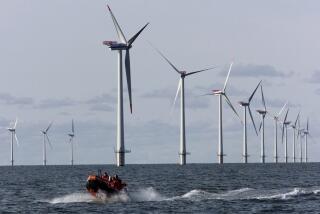Where’d the wind go?
- Share via
Ayear ago the Oracle of Oil, T. Boone Pickens, reinvented himself as the Wizard of Wind, launching a $58-million ad campaign to boost alternative energy and vowing to spend $10 billion to build the world’s largest wind farm in the Texas Panhandle. It was a startling move from a staunch conservative who had made a fortune in the Texas oil fields, raising hopes that both ends of the political spectrum were coming around to the same point of view about weaning the country from its reliance on oil.
And then, last week, the Pickens plan foundered. Pickens announced that he was scrapping the wind farm. It’s too late to take back the $2 billion worth of wind turbines he has already ordered, so instead he has decided to place them in smaller projects around the country.
Pickens isn’t the only renewable-energy entrepreneur facing troubles. Wind projects have been increasing sharply in recent years, rising last year by 8,545 megawatts of installed capacity nationally, according to the American Wind Energy Assn. But the trade group expects to see the first decline in new capacity since 2004 this year, projecting that only about 5,000 megawatts will be developed. That’s a statistic that should depress both liberals who look to clean power as a solution to climate change and conservatives who want to reduce U.S. dependence on foreign oil.
So what’s going wrong? The recession and the discovery of new supplies have depressed natural gas prices, making gas-fired power plants more economically competitive than renewable energy. Another consequence of the recession is that lenders that were once eager to put up the money for renewable-energy projects have pulled back. And the expense and difficulty of building transmission lines from remote wind farms to urban centers is forcing many, including Pickens, to drop ambitious projects in favor of smaller ones in places where transmission lines already exist.
The Obama administration helped improve matters last week when it announced that it would soon accept applications for $3 billion in renewable-energy grants approved as part of the economic stimulus package. But Congress could do far more, starting with setting a strong renewable-power standard as part of climate-change legislation being considered in the Senate. That bill also should include provisions that would ease construction of high-voltage transmission lines by first identifying high-priority corridors, then giving federal regulators full authority over siting lines in those areas.
State officials would grumble about that, but the federal government already has similar authority over the siting of natural-gas pipelines, and access to renewable power should be considered at least as high a national priority as access to natural gas.
More to Read
Inside the business of entertainment
The Wide Shot brings you news, analysis and insights on everything from streaming wars to production — and what it all means for the future.
You may occasionally receive promotional content from the Los Angeles Times.









